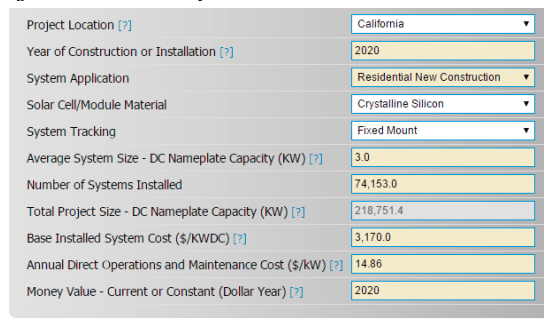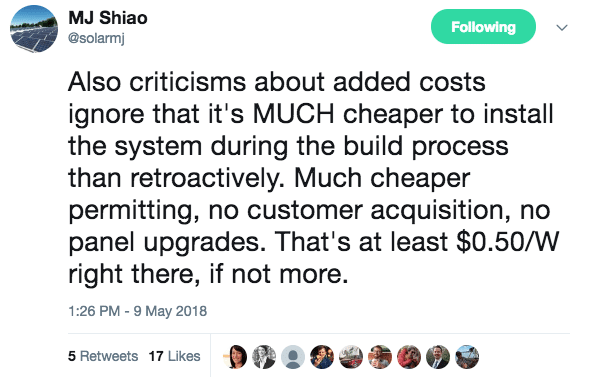Yesterday’s landmark decision by the California Energy Commission (CEC) to mandate solar on all new homes* through the building code may in the long run be the biggest deal for the global solar industry since Germany passed its feed-in tariff in 2003.
In this article, we will try to briefly answer some of the pressing questions regarding this wide-ranging decision.
1: How much solar will be added?
This is not clear. The biggest variable here does not have to do with solar, but new home construction. Residential construction peaked in California in 2004 at over 200,000 units, and reached a low of only 36,400 units in 2010 during the recession. It has increased every year since then, and was at 113,000 units last year.
So while many analysts will be using last year’s number, it is not clear that California’s residential construction market has run out of steam yet, as the number of units is still around half of what it was during the 2004 peak.
The additional cost of adding solar may slow this rise somewhat, but as the average valuation of each new unit is over $300,000, this is a minor factor compared to the many others in this market. And with extremely high housing prices, it is clear that California’s booming economy still needs homes.
Even if we make the conservative assumption that California’s housing construction market stays flat, this is still over 100,000 units per year. However, roughly half that is in multi-family buildings (apartments or condominiums), with most being five units or more. The characteristics of solar deployment on these buildings will be very different than single-family homes, as they typically have less roof area per unit.
 The CEC’s own modeling assumes 74,000 new installations at an average system size of 3 kW in 2020, meaning an additional 219 MW of solar. This appears to assume that the requirements will be met using community solar for a significant portion of new homes, and these installations do not appear to counted in this number.
The CEC’s own modeling assumes 74,000 new installations at an average system size of 3 kW in 2020, meaning an additional 219 MW of solar. This appears to assume that the requirements will be met using community solar for a significant portion of new homes, and these installations do not appear to counted in this number.
But it is anyone’s guess what the housing construction market will do from year to year. Additionally, there is the question of whether or not homebuilders will install minimum-size systems, given the economies of scale that can be gained from larger PV systems.
The latter may be the bigger question. As 127,000 residential PV systems were installed in California last year, this mandate could double the total addressable market on a per-system basis.
2: Who will be installing/financing all of that solar?
The short answer is that this means more business for all 2,387 companies in California’s solar industry, and for the thousands of companies in other states.
However, in an analysis released this morning, Guggenheim notes that large national solar installers and financiers are likely to benefit the most from this ruling, as they are more likely to establish successful relationships with homebuilders, and thus gain a larger market share.
The report led by Analyst Sophie Karp notes that competition among top players will likely intensify, but also sees Sunrun as the “best positioned”, given that it has the strongest presence, with an estimated 40% of Sunrun’s installations in the state.
pv magazine’s John Weaver notes that this could also increase the market share of Tesla, due to its Solar Roof offering.
3: What will it cost?
The ink was not yet dry on California’s new mandate before certain publications began writing sky-is-falling warnings about the cost of the mandate, with MIT Tech Review and Orange County Register featuring extended hand-wringing, inflated estimates and incomplete analyses.
The California Energy Commission’s own report puts the cost of new solar at from $7,900 to $17,700, depending on the climate zone that the new PV installations will be located in, with most in the $8,000-$9,000 range.
 One factor to be considered is that it is much cheaper to install solar on new homes than to retrofit it on existing roofs. On Twitter, GTM Research Head of Americas Research MJ Shiao estimates savings of at least $0.50 per watt.
One factor to be considered is that it is much cheaper to install solar on new homes than to retrofit it on existing roofs. On Twitter, GTM Research Head of Americas Research MJ Shiao estimates savings of at least $0.50 per watt.
Overall the California Energy Commission found that the requirement would be cost-effective in every climate zone, by eliminating the need for 323 gigawatt-hours of electricity, and thus eliminating 114,000 metric tons of greenhouse gas emissions – in the first year alone.
4: What type of solar?
pv magazine’s John Weaver looked into this yesterday, emphasizing the market for Tesla’s Solar Roof and other building integrated photovoltaic (BIPV) options such as Real Goods’ Powerhouse and Hanergy’s Hantiles. While BIPV will likely be considered for the higher end of the market, it is unclear how much of the total it will represent.
Given that this is a mandate, some homeowners may go with the least expensive, minimal option. However, for space-constrained roofs and small installations where PV modules make up a small portion of total system prices, higher efficiency products often pay for themselves.
Another important thing to note is that a portion of this mandate will be met with community solar, particularly for those buildings where shading or other factors make rooftop solar impractical. As such, it will drive demand for inexpensive multicrystalline silicon and other options such as First Solar’s CdTe thin film PV, as well as the more high-efficiency rooftop products.
5: What does this mean for other states and nations?
The saying is that as California goes, so goes the nation. California has led the United States in solar deployment, and the California Solar Initiative’s block grants have served as a model for other successful solar incentive programs in New York and Massachusetts.
As such, we expect that even as states such as Connecticut, Maine and Michigan retreat into the past and build moats around their utilities, that other states will consider similar mandates. As this is why this is the biggest thing to happen to solar since Germany’s feed-in tariff.
* Editor’s note: There is also the option to subscribed to a community solar installation on behalf of the home and its occupants, in lieu of installing solar.
This content is protected by copyright and may not be reused. If you want to cooperate with us and would like to reuse some of our content, please contact: editors@pv-magazine.com.









By submitting this form you agree to pv magazine using your data for the purposes of publishing your comment.
Your personal data will only be disclosed or otherwise transmitted to third parties for the purposes of spam filtering or if this is necessary for technical maintenance of the website. Any other transfer to third parties will not take place unless this is justified on the basis of applicable data protection regulations or if pv magazine is legally obliged to do so.
You may revoke this consent at any time with effect for the future, in which case your personal data will be deleted immediately. Otherwise, your data will be deleted if pv magazine has processed your request or the purpose of data storage is fulfilled.
Further information on data privacy can be found in our Data Protection Policy.